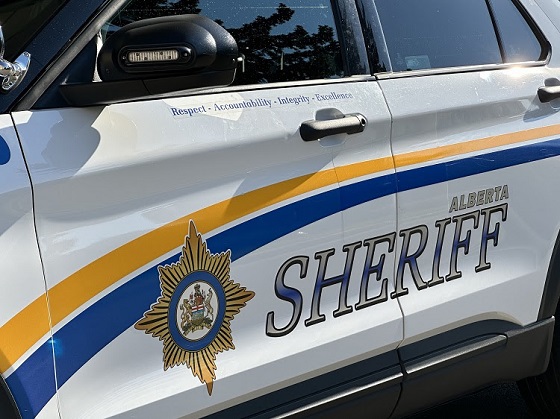Alberta Sheriffs Branch
Crown appeal against acquitted peaceful protestor Evan Blackman back in court June 19

News release from the Justice Centre for Constitutional Freedoms
The Justice Centre for Constitutional Freedoms announces that a hearing date for Evan Blackman’s summary conviction appeal has been set for June 19, 2024. The hearing will take place at the Ontario Superior Court of Justice in Ottawa.
The Crown’s evidence against Blackman at his trial consisted of a 14-minute drone video, with no sound, and the testimony of one officer from the scene. For nine minutes of that video, Blackman is seen as part of a group of protestors standing across from a line of police officers on Rideau Street in downtown Ottawa. Blackman is shown de-escalating the situation by holding other protestors back and putting his hand up to stop them from confronting the officers. He is then seen kneeling in front of police for the five minutes prior to his arrest. At one point, while on his knees, he takes off his hat, puts his hands on his chest, and starts singing Canada’s national anthem.
The Ottawa Crown Attorney’s Office is appealing Blackman’s acquittal on charges of mischief and obstructing the police relating to his participation in the Freedom Convoy protests, specifically on February 18, 2022, the day police conducted an “enforcement action” – clearing Ottawa city streets following the invocation of the Emergencies Act by the federal government four days prior.
Blackman was acquitted after a one-day trial on October 23, 2023. The Justice Centre provided lawyers for Blackman’s defence at that trial and continues to support him throughout this appeal.
At trial, Mr. Blackman pled “not guilty” to all charges. The judge dismissed the case against him due to limited evidence and the poor memory of a police witness on key elements of the criminal offenses.
After his February 18, 2022 arrest and release the same day, Blackman discovered his three bank accounts had been frozen pursuant to the Emergency Economic Measures Order.
Chris Fleury, lawyer for Blackman, notes that if his client had been convicted, his intention was to bring an application for a stay of proceedings under section 24(1) of the Charter, seeking a remedy for the freezing of Mr. Blackman’s bank account. If Mr. Blackman’s acquittal is overturned on appeal, he intends to file this application.
Chris Fleury says, “The limited evidence available at Mr. Blackman’s trial showed Mr. Blackman attempting to de-escalate a volatile situation between police and protestors on February 18. He pled not guilty to the criminal offences that he was charged with, and the trial judge ultimately agreed and found him not guilty. This appeal is an attempt by the Crown to reframe findings of fact that they disagree with as legal errors. Mr. Blackman and I are looking forward to our day in Court at the appeal hearing.”
Alberta
Province to expand services provided by Alberta Sheriffs: New policing option for municipalities

Expanding municipal police service options |
Proposed amendments would help ensure Alberta’s evolving public safety needs are met while also giving municipalities more options for local policing.
As first announced with the introduction of the Public Safety Statutes Amendment Act, 2024, Alberta’s government is considering creating a new independent agency police service to assume the police-like duties currently performed by Alberta Sheriffs. If passed, Bill 49 would lay additional groundwork for the new police service.
Proposed amendments to the Police Act recognize the unique challenges faced by different communities and seek to empower local governments to adopt strategies that effectively respond to their specific safety concerns, enhancing overall public safety across the province.
If passed, Bill 49 would specify that the new agency would be a Crown corporation with an independent board of directors to oversee its day-to-day operations. The new agency would be operationally independent from the government, consistent with all police services in Alberta. Unlike the Alberta Sheriffs, officers in the new police service would be directly employed by the police service rather than by the government.
“With this bill, we are taking the necessary steps to address the unique public safety concerns in communities across Alberta. As we work towards creating an independent agency police service, we are providing an essential component of Alberta’s police framework for years to come. Our aim is for the new agency is to ensure that Albertans are safe in their communities and receive the best possible service when they need it most.”
Additional amendments would allow municipalities to select the new agency as their local police service once it becomes fully operational and the necessary standards, capacity and frameworks are in place. Alberta’s government is committed to ensuring the new agency works collaboratively with all police services to meet the province’s evolving public safety needs and improve law enforcement response times, particularly in rural communities. While the RCMP would remain the official provincial police service, municipalities would have a new option for their local policing needs.
Once established, the agency would strengthen Alberta’s existing policing model and complement the province’s current police services, which include the RCMP, Indigenous police services and municipal police. It would help fill gaps and ensure law enforcement resources are deployed efficiently across the province.
Related information
Alberta
New surveillance teams led by the Alberta Sheriffs working with local police in rural communities

More boots on the ground to fight rural crime
Rural crime continues to be a top concern among residents and businesses in rural Alberta, which is why Alberta’s government remains committed to addressing it through enhanced surveillance and other crime reduction initiatives. Alberta’s government invested $4.3 million for the Alberta Sheriffs to put more boots on the ground. This investment supported the establishment of two plainclothes teams – one in northern Alberta and one in southern Alberta – to support police in carrying out surveillance on criminal targets in rural areas.
Both teams are now fully staffed and operational, ready to fight crime in rural areas across Alberta. These rural surveillance teams will work to prevent crime, monitor agricultural theft and work in collaboration with local law enforcement to share intelligence and resources to keep Albertans and their property safe and secure.
“Criminals and organized crime are not welcome in Alberta. Full stop. The addition of two new surveillance teams will further support our law enforcement partners in stamping out criminal activity in Alberta’s rural areas. This is about supporting local investigations to address local crime in our smaller communities. Together, both teams will form another key component of Alberta’s efforts to combat crime and ensure Albertans feel safe at home and in their communities, regardless of where they live.”
The Alberta Sheriffs have an existing surveillance unit that is part of the Alberta Law Enforcement Response Teams (ALERT) and focused mainly on serious and organized crime investigations. The new surveillance teams will fill a gap by helping rural RCMP detachments with local investigations.
“Through their specialized knowledge, training and experience, Alberta’s new surveillance teams are providing another important mechanism in the fight against crime in Alberta’s rural communities. Working in close collaboration with the RCMP and other policing agencies, their efforts will play a key role in gathering evidence and information that will help disrupt crime throughout the province.”
“This announcement by the Alberta government and Minister Ellis is a positive step forward for the residents of Alberta, especially in rural areas. Targeting known criminals is a very effective way to reduce the level of crime taking place and will greatly assist the RCMP who have a vast area to police.”
“We are happy to hear about increased resources being allocated to assist our communities. Addressing rural crime is one of the top priorities of the Alberta RCMP, and our partners at the Alberta Sheriffs already play a vital role in keeping Albertans safe. The creation of these new surveillance teams will help augment our ongoing crime reduction strategies in Alberta communities, and we look forward to working with them going forward.”
The new surveillance teams are part of a suite of measures to expand the role of the Alberta Sheriffs and make Alberta communities safer. Other actions include the expansion of the Safer Communities and Neighbourhoods (SCAN) unit – which uses legal sanctions and court orders to target problem properties where illegal activities are taking place – and the expansion of the RAPID Response initiative with funding for the Sheriff Highway Patrol to train and equip members to assist the RCMP with emergencies and high-priority calls.
Related news
- Fighting rural crime (March 24, 2023)
Multimedia
-

 Alberta7 hours ago
Alberta7 hours agoAlberta Independence Seekers Take First Step: Citizen Initiative Application Approved, Notice of Initiative Petition Issued
-

 Crime6 hours ago
Crime6 hours agoNational Health Care Fraud Takedown Results in 324 Defendants Charged in Connection with Over $14.6 Billion in Alleged Fraud
-

 Health5 hours ago
Health5 hours agoRFK Jr. Unloads Disturbing Vaccine Secrets on Tucker—And Surprises Everyone on Trump
-

 Bruce Dowbiggin8 hours ago
Bruce Dowbiggin8 hours agoThe Game That Let Canadians Forgive The Liberals — Again
-

 Alberta1 day ago
Alberta1 day agoCOVID mandates protester in Canada released on bail after over 2 years in jail
-

 armed forces1 day ago
armed forces1 day agoCanada’s Military Can’t Be Fixed With Cash Alone
-

 Crime2 days ago
Crime2 days agoProject Sleeping Giant: Inside the Chinese Mercantile Machine Linking Beijing’s Underground Banks and the Sinaloa Cartel
-

 Alberta2 days ago
Alberta2 days agoAlberta uncorks new rules for liquor and cannabis






